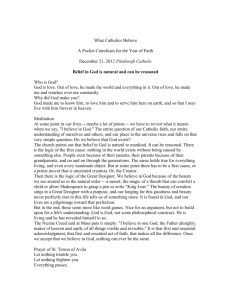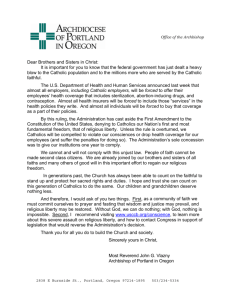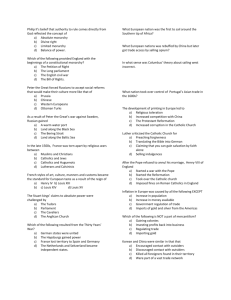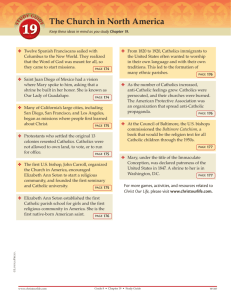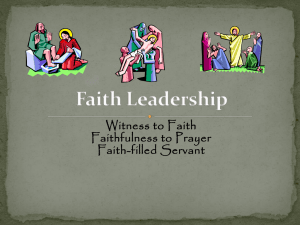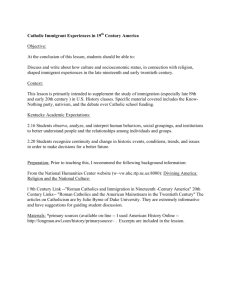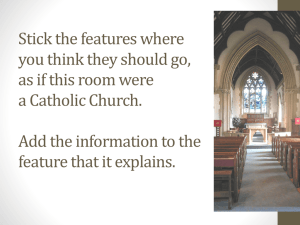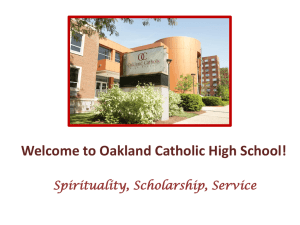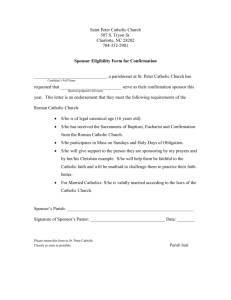A Tale of Two Churches
advertisement
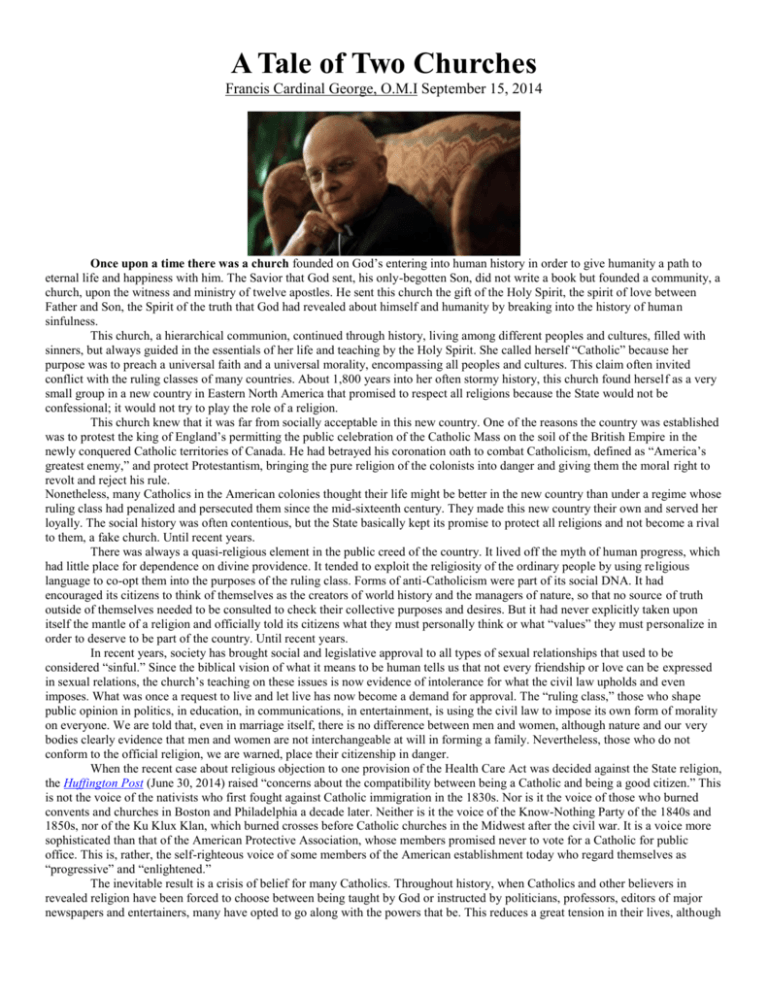
A Tale of Two Churches Francis Cardinal George, O.M.I September 15, 2014 Once upon a time there was a church founded on God’s entering into human history in order to give humanity a path to eternal life and happiness with him. The Savior that God sent, his only-begotten Son, did not write a book but founded a community, a church, upon the witness and ministry of twelve apostles. He sent this church the gift of the Holy Spirit, the spirit of love between Father and Son, the Spirit of the truth that God had revealed about himself and humanity by breaking into the history of human sinfulness. This church, a hierarchical communion, continued through history, living among different peoples and cultures, filled with sinners, but always guided in the essentials of her life and teaching by the Holy Spirit. She called herself “Catholic” because her purpose was to preach a universal faith and a universal morality, encompassing all peoples and cultures. This claim often invited conflict with the ruling classes of many countries. About 1,800 years into her often stormy history, this church found herself as a very small group in a new country in Eastern North America that promised to respect all religions because the State would not be confessional; it would not try to play the role of a religion. This church knew that it was far from socially acceptable in this new country. One of the reasons the country was established was to protest the king of England’s permitting the public celebration of the Catholic Mass on the soil of the British Empire in the newly conquered Catholic territories of Canada. He had betrayed his coronation oath to combat Catholicism, defined as “America’s greatest enemy,” and protect Protestantism, bringing the pure religion of the colonists into danger and giving them the moral right to revolt and reject his rule. Nonetheless, many Catholics in the American colonies thought their life might be better in the new country than under a regime whose ruling class had penalized and persecuted them since the mid-sixteenth century. They made this new country their own and served her loyally. The social history was often contentious, but the State basically kept its promise to protect all religions and not become a rival to them, a fake church. Until recent years. There was always a quasi-religious element in the public creed of the country. It lived off the myth of human progress, which had little place for dependence on divine providence. It tended to exploit the religiosity of the ordinary people by using religious language to co-opt them into the purposes of the ruling class. Forms of anti-Catholicism were part of its social DNA. It had encouraged its citizens to think of themselves as the creators of world history and the managers of nature, so that no source of truth outside of themselves needed to be consulted to check their collective purposes and desires. But it had never explicitly taken upon itself the mantle of a religion and officially told its citizens what they must personally think or what “values” they must personalize in order to deserve to be part of the country. Until recent years. In recent years, society has brought social and legislative approval to all types of sexual relationships that used to be considered “sinful.” Since the biblical vision of what it means to be human tells us that not every friendship or love can be expressed in sexual relations, the church’s teaching on these issues is now evidence of intolerance for what the civil law upholds and even imposes. What was once a request to live and let live has now become a demand for approval. The “ruling class,” those who shape public opinion in politics, in education, in communications, in entertainment, is using the civil law to impose its own form of morality on everyone. We are told that, even in marriage itself, there is no difference between men and women, although nature and our very bodies clearly evidence that men and women are not interchangeable at will in forming a family. Nevertheless, those who do not conform to the official religion, we are warned, place their citizenship in danger. When the recent case about religious objection to one provision of the Health Care Act was decided against the State religion, the Huffington Post (June 30, 2014) raised “concerns about the compatibility between being a Catholic and being a good citizen.” This is not the voice of the nativists who first fought against Catholic immigration in the 1830s. Nor is it the voice of those who burned convents and churches in Boston and Philadelphia a decade later. Neither is it the voice of the Know-Nothing Party of the 1840s and 1850s, nor of the Ku Klux Klan, which burned crosses before Catholic churches in the Midwest after the civil war. It is a voice more sophisticated than that of the American Protective Association, whose members promised never to vote for a Catholic for public office. This is, rather, the self-righteous voice of some members of the American establishment today who regard themselves as “progressive” and “enlightened.” The inevitable result is a crisis of belief for many Catholics. Throughout history, when Catholics and other believers in revealed religion have been forced to choose between being taught by God or instructed by politicians, professors, editors of major newspapers and entertainers, many have opted to go along with the powers that be. This reduces a great tension in their lives, although it also brings with it the worship of a false god. It takes no moral courage to conform to government and social pressure. It takes a deep faith to “swim against the tide,” as Pope Francis recently encouraged young people to do at last summer’s World Youth Day. Swimming against the tide means limiting one’s access to positions of prestige and power in society. It means that those who choose to live by the Catholic faith will not be welcomed as political candidates to national office, will not sit on editorial boards of major newspapers, will not be at home on most university faculties, will not have successful careers as actors and entertainers. Nor will their children, who will also be suspect. Since all public institutions, no matter who owns or operates them, will be agents of the government and conform their activities to the demands of the official religion, the practice of medicine and law will become more difficult for faithful Catholics. It already means in some States that those who run businesses must conform their activities to the official religion or be fined, as Christians and Jews are fined for their religion in countries governed by Sharia law. A reader of the tale of two churches, an outside observer, might note that American civil law has done much to weaken and destroy what is the basic unit of every human society, the family. With the weakening of the internal restraints that healthy family life teaches, the State will need to impose more and more external restraints on everyone’s activities. An outside observer might also note that the official religion’s imposing whatever its proponents currently desire on all citizens and even on the world at large inevitably generates resentment. An outside observer might point out that class plays a large role in determining the tenets of the official State religion. “Same-sex marriage,” as a case in point, is not an issue for the poor or those on the margins of society. How does the tale end? We don’t know. The actual situation is, of course, far more complex than a story plot, and there are many actors and characters, even among the ruling class, who do not want their beloved country to transform itself into a fake church. It would be wrong to lose hope, since there are so many good and faithful people. Catholics do know, with the certainty of faith, that, when Christ returns in glory to judge the living and the dead, the church, in some recognizable shape or form that is both Catholic and Apostolic, will be there to meet him. There is no such divine guarantee for any country, culture or society of this or any age. Editor’s note: This column first appeared in the September 7 – 20, 2014 edition of Catholic New World, the newspaper of the Archdiocese of Chicago. (Photo credit: E. Jason Wambsgans / Chicago Tribune)
